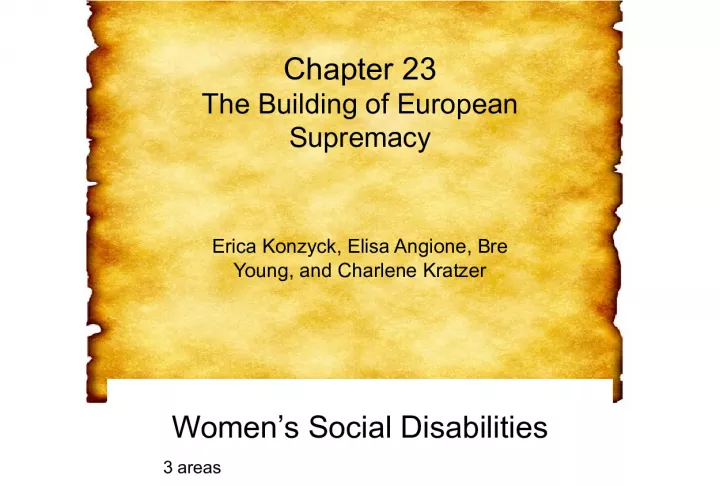Married Women's Property Rights in European Supremacy


This chapter explores the social disability faced by women in the areas of property rights in Europe. Married women were not allowed to own property in their own name, regardless of their social
- Uploaded on | 0 Views
-
 gustomisl
gustomisl
About Married Women's Property Rights in European Supremacy
PowerPoint presentation about 'Married Women's Property Rights in European Supremacy'. This presentation describes the topic on This chapter explores the social disability faced by women in the areas of property rights in Europe. Married women were not allowed to own property in their own name, regardless of their social. The key topics included in this slideshow are . Download this presentation absolutely free.
Presentation Transcript
Slide1Chapter 23The Building of European Supremacy Erica Konzyck, Elisa Angione, Bre Young, and Charlene Kratzer
Slide2Women’s Social Disabilities3 areas • Property rights – married women couldn’t own property in their own name, no matter social class – when married, women lost all property to husband – 1882, Married Women’s Property Act, passed by Great Britain allowed married women to own property in their own right • Family law – legal codes required wives to “give obedience” to their husbands – divorce was difficult
Slide3Social Disabilities, Con’t.• Education – women had less access to education than men and what was available was inferior – more illiterate women than men – Italian universities were more open to women than other institutions in Europe – women who attended universities were sometimes labeled political radicals
Slide4New Employment Patterns forWomen • 2 major developments – Availability of New Jobs • elementary school, typist, telephone operator, secretaries, clerks for governments and private businesses and shop assistants – Withdrawal From the Labor Force • upon marriage a woman normally withdrew from the work force • employers preferred young, unmarried women whose family responsibilities wouldn’t interfere with work
Slide5Working Class Women• Mainly employed by textile and garment industries. • Very vulnerable to exploitation due to the “Putting-out System.” • Putting-out System- manufacturers buy materials and send them out for tailoring, generally to small independent sweat shops or home workers to make the garments. By 1896 this system employed over 80,000 people.
Slide6Poverty and Prostitution• Poverty and a need for work often led to prostitution. • Prostitutes were often born into families of unskilled workers, and in turn had little skill, or had just moved from a rural area and were in need of quick income. It was also common for orphans and children of broken homes to turn to prostitution. • It was legal, but subject to regulation.
Slide7Women of the Middle Class• There was a vast gap between the middle and the working class. • Middle class women typically did not work, but were very defined to the domestic sphere. • For middle class women the home became a center for virtue, children, and respectable life. • For economic stability marriages were often arranged. Romantic marriages were seen as a threat. • Near the end of the century came the acceptance of small family size, and the development of new contraceptives. This caused birthrates to fall. • Middle class women were assigned firm religious duties, and were expected to frequently attend mass and assure their children’s religious education.
Slide8Political Feminism• Obstacles – Women slow to support – Feminists argued over tatics and goals – Male supporters only hardened resistance – Continental feminists could not raise massive public support
Slide9Most Advanced Women’s Movement• Millie Fawcett’s Suffrage society was nonviolent, because need to be politically responsible, respectful. V.S. • Emmeline Pankhurst’s Suffragettes displayed violence, and marched en masse on Parliament VERDICT: Britain granted women right to vote at age 31, because of their contributions in WWI.
Slide10Feminism ElsewhereFrance: Their women’s council was slow to advocate voting. Feminists were nonviolent, legalists. Thus, granted after WW2. Germany: Women had no political rights. Granted in 1919, gov’t vulnerable after work in defeat and revolution. Norway: First to allow women to vote on national issues.
Slide11Jewish Emancipation• In Germany, Italy, the Low Countries, Scandinavia, and Austria-Hungary, Jews attained full citizenship. • Jews could sit in parliament in Great Britain (1858) • In Russia and Poland, however, traditional modes of prejudice continued. • Russian Government undermined Jewish community life, such as banning Jews from state services and restricting where they should live.